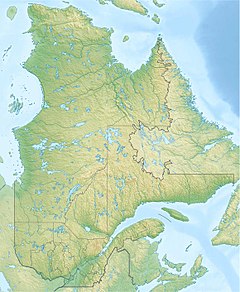
Back نهر سان چان ARZ Rivière Saint-Jean (Saguenay) German Rivière Saint-Jean (rivière Saguenay) French
| Saint-Jean River | |
|---|---|
 | |
| Location | |
| Country | Canada |
| Province | Quebec |
| Region | Capitale-Nationale and Saguenay-Lac-Saint-Jean |
| Regional County Municipality | Le Fjord-du-Saguenay Regional County Municipality |
| Municipalities | L'Anse-Saint-Jean |
| Physical characteristics | |
| Source | Brébeuf Lake |
| • location | Rivière-Éternité |
| • coordinates | 48°11′07″N 70°35′53″W / 48.18528°N 70.59805°W |
| • elevation | 226 m (741 ft) |
| Mouth | Saguenay River |
• location | L'Anse-Saint-Jean |
• coordinates | 48°14′29″N 70°11′53″W / 48.24139°N 70.19805°W |
• elevation | 3 m (9.8 ft) |
| Length | 38.8 km (24.1 mi)[1] |
| Discharge | |
| • location | L'Anse-Saint-Jean |
| Basin features | |
| Tributaries | |
| • left | (from the mouth) Ruisseau Girard, ruisseau à Denis, outlet of two lakes, outlet of lac Étienne. |
| • right | (from the mouth) Ruisseau Patrice-Fortin, Bras à Pierre, outlet of few lakes, Cami River. |
The Saint-Jean River (St. John River) is a river crossing the municipalities of Rivière-Éternité and L'Anse-Saint-Jean in the Le Fjord-du-Saguenay Regional County Municipality, in the administrative region of Saguenay-Lac-Saint-Jean, Quebec, Canada.
The upper portion of the Saint John River is integrated into Zec du Lac-Brébeuf, a controlled harvesting zone (ZEC).
The Saint-Jean River is served primarily by route 170 (east-west), which passes through the hamlets "Le Ruisseau-du-Portage" and "La Chute-à-Salum". Some other secondary forest roads serve the lake area mainly for forestry and recreational tourism purposes.
Forestry is the main economic activity of the sector; recreational tourism activities, second.
The surface of the Saint John River is usually frozen from late November to early April (except in rapids areas), however, safe ice movement is generally from mid-December to late March.
- ^ "Saint-Jean River (Saguenay) | Bank of Quebec place names". Commission de toponymie du Québec. Retrieved December 10, 2019.
